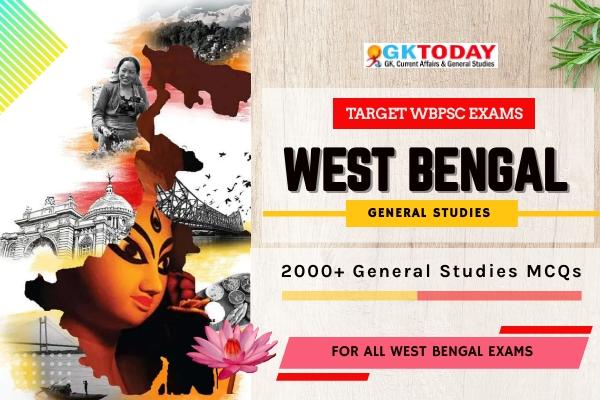States PCS: West Bengal GK Questions for WBPSC Examinations
For all West Bengal Public Service Commission (WBPSC) exams including WBCS, JE, AE, and other state-level competitive examinations.
1. Who has been honoured with Lifetime Achievement Award by the West Bengal Film Journalists Association (WBFJA)?
[A] Mithun Chakrabarty
[B] Buddhadeb Dasgupta
[C] Moushumi Chatterjee
[D] Subhashish Mukherjee
Show Answer
Correct Answer: B [Buddhadeb Dasgupta]
Notes:
National award-winning filmmaker Buddhadeb Dasgupta has been honoured with the Lifetime Achievement Award by the West Bengal Film Journalists Association (WBFJA). The award is in the name of the late Satyajit Ray. He was awarded the award in the third edition of the ‘Cinemar Samabartan’ ceremony on January13, 2019. Dasgupta is a big name in the parallel cinema. He is known for his political films like “Dooratwa” (Distance) and “Grihajuddha” (Crossroads). As a director, he has won the National Film Award for Best Direction twice, for “Uttara” (2000) and “Swapner Din” (2005).
2. Which river forms a boundary between Odisha and West Bengal?
[A] Mahanadi
[B] Rushikulya
[C] Subarnarekha
[D] Godavari
Show Answer
Correct Answer: C [Subarnarekha]
Notes:
Subarnarekha river forms a boundary between West Bengal and Odisha. It flows over the district of Mayurbhanj and Balasore.
3. Apart from Chandragupta, who was responsible for the expansion of Mauryan dynasty into India’s Central and Southern regions?
[A] Ashoka
[B] Bindusara
[C] Kanishka
[D] Prabhavati Gupta
Show Answer
Correct Answer: B [Bindusara ]
Notes:
The Mauryan empire was one of the world’s largest empires in its time and became the largest ever in the Indian sub-continent including Bengal due to its expansion into India’s Central and Southern regions by the emperors Chandragupta and Bindusara. Thus entire region of Bengal came under the Mauryan empire.
4. According to the scholars,how many racial elements came together to form Bangalee race?
[A] 5
[B] 4
[C] 3
[D] 6
Show Answer
Correct Answer: C [3]
Notes:
There were three major racial elements which
came together to form the Bengalee race– they were the Dravidians, the Mangolian
tribes and the Aryans.
5. Which Chinese monk traveled to India during the time of Shashanka?
[A] Tong Achew
[B] Fa-Hien
[C] Hiuen Tsang
[D] Both (a) & (c)
Show Answer
Correct Answer: C [Hiuen Tsang]
Notes:
Hieun Tsang, the Chinese pilgrim, visited India during the reign of Harshavardhana with an aim of securing authentic Buddhist scripts. The Kannauj assembly (643 AD) was held in the honour of Hieun Tsang and to popularise Mahayana sect of Buddhism.
6. Who among these name is not an accomplished writer at Harshavardhana’s court?
[A] Matanga Divakara
[B] Mayura
[C] Banabhatta
[D] Bodhisattva
Show Answer
Correct Answer: D [Bodhisattva]
Notes:
Banabhatta (author of Harshacharita and Parvatiparinay), Mayura (author of Mayurashataka), renroned grammarian Bhartrihari (author of Vakapadiya), and Matanga Divakara were the accomplished writers at Harshavardhana’s court.
7. What are simple structures consisted of a shrine room, date to the Gupta period called?
[A] Vajrayana
[B] Temples
[C] Garbhagrha
[D] Kumbakonam
Show Answer
Correct Answer: C [Garbhagrha]
Notes:
The earliest remains of a Hindu temple, discovered at Sanchi, date to the Gupta period. These extremely simple structures consisted of a shrine room, called a garbhagrha (“womb house,” or sanctum sanctorum), which contained an image of the deity and opened onto a porch.
8. Which of these is not a weapon used in Upper Palaeolithic Period?
[A] Spear thrower
[B] Harpoon
[C] Bone tools
[D] Javelin
Show Answer
Correct Answer: D [Javelin ]
Notes:
The hand axes and flake tools of the earlier assemblages were replaced by diversified and specialized tools made on blades struck from specially prepared cores. Many important inventions appeared, such as needles and thread, skin clothing, hafted stone and bone tools, the harpoon, the spear thrower, and special fishing equipment. Bone, ivory, and antler, in addition to flint, were extensively used in Upper Palaeolithic Age.
9. Who addressed Radha as Rahim and Rabbani?
[A] Hachhan Raja Chaudhury
[B] Raja Krishnachandra
[C] Hasan Mirik
[D] Syeed Mainuddin
Show Answer
Correct Answer: A [Hachhan Raja Chaudhury ]
Notes:
A few Muslim Vaisnava poets have indicated God by using
the name of Radha-Krishna. To Hachhan Raja Chaudhury (Husain Raza) of Sylhet district there is no difference between Radha and Khoda. He addressed Radha as Rahim and Rabbani.
10. Who wrote Akbarnama?
[A] Qyed Sadri
[B] Mehram Khan
[C] Faiz Kazi
[D] Abul Fazl
Show Answer
Correct Answer: D [Abul Fazl]
Notes:
According to Abul Fazl, a 16th-century historian and the author of Akbarnama: Isa Khan’s father was born in Bais. He revolted and was later killed in a battle against Islam Shah Suri.

